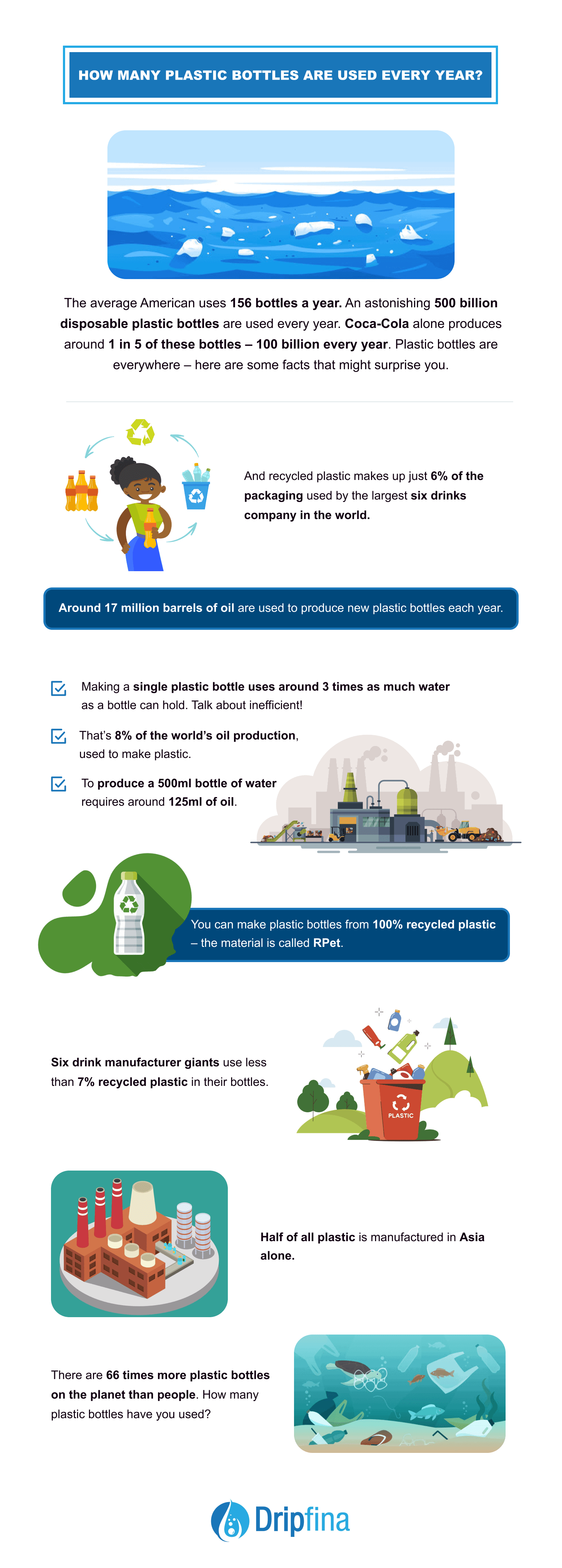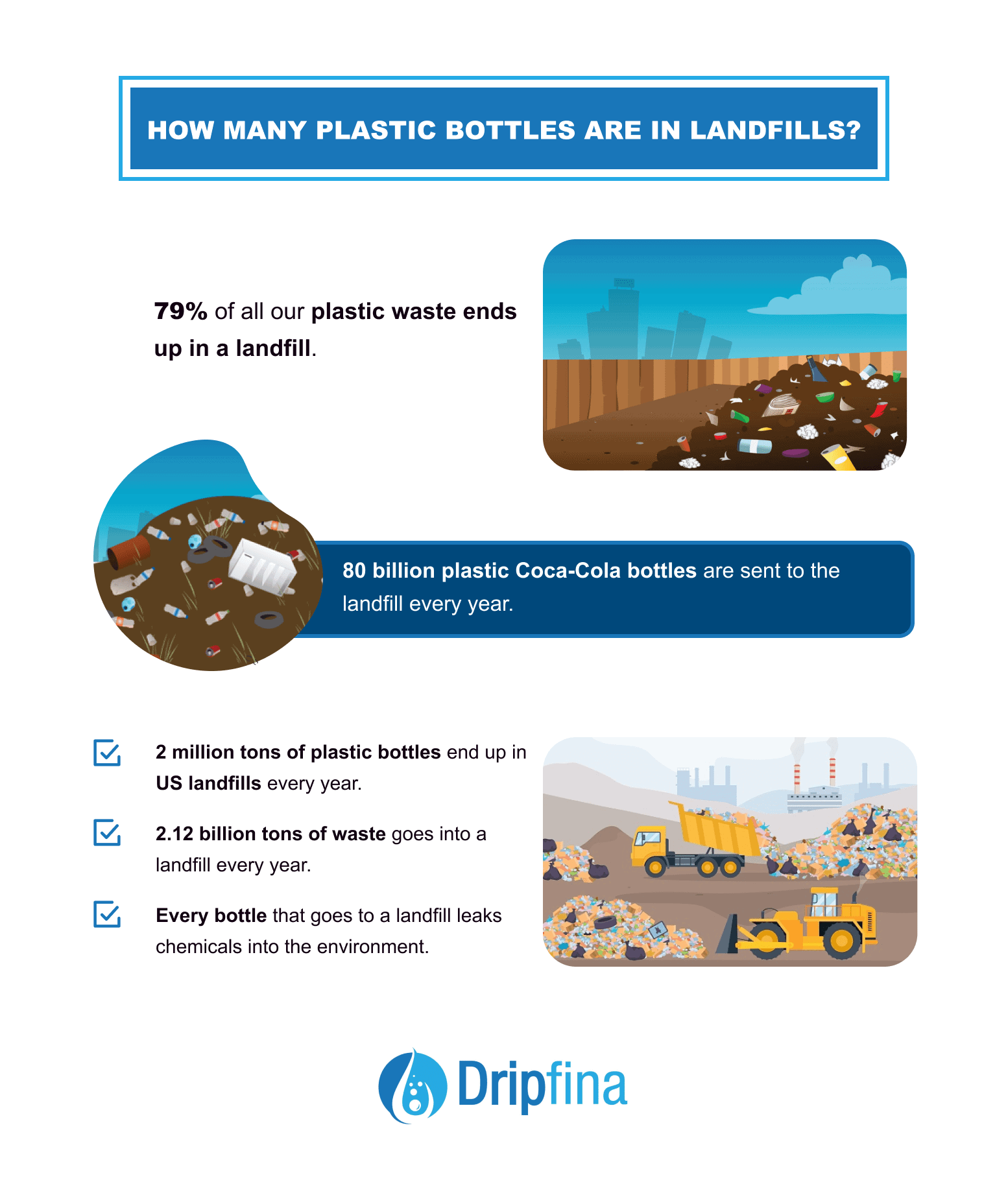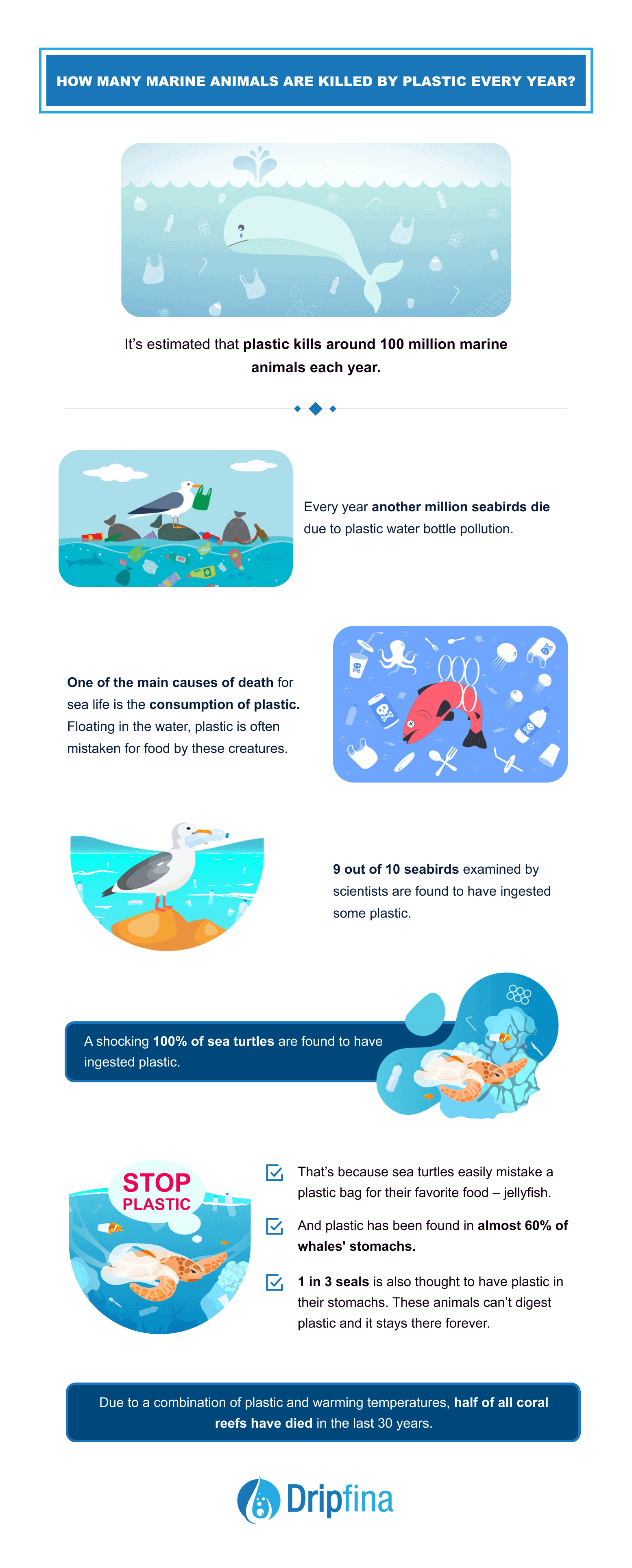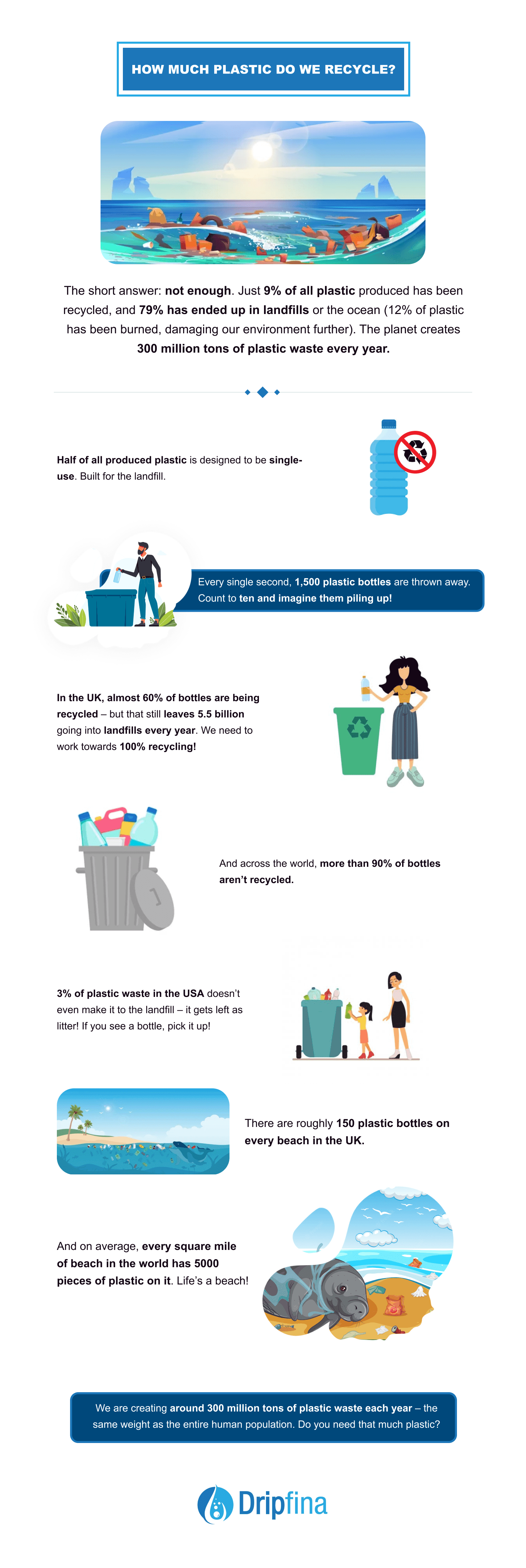
Plastic – a ubiquitous material in our lives. From microfibres in the clothes we wear to the containers our food comes in, there’s no escaping plastic in the modern world.
And increasingly, when it comes to water, plastic is never far from hand. We’ve become addicted to buying plastic water bottles and whether it’s sparkling, flavored or still it’s always plastic.
Plastic is so normalized in our lives that it’s hard to imagine a world without it. And when we see something every day, we forget about the hidden world of production and consumption and waste that revolves around it, just out of view.
Whilst global plastic production appears to have peaked in 2019 with 368 million tons, the effects of COVID and global shutdowns may also have suppressed the numbers. In 2023, plastic production is on the rise, and as our alarming statistics show, the vast majority of this plastic is never recycled.
As plastic piles up in landfills, on beaches and in coral reefs across our world, you may be wondering what can be done.
Armed with plastic facts and statistics, you can start making a difference to plastic consumption and recycling. Share these shocking facts with your friends and family to create a rippling effect, reducing plastic consumption in your community.
Water you waiting for? Here are the essential plastic water bottle statistics at a glance:
Key Insights:
- An average American uses 156 water bottles a year. Across the globe, we use 1.4 billion plastic bottles every day.
- A single plastic bottle takes 450 million years to decompose.
- 8 million tons of plastic bottle pollution end up in the ocean every year!
- By 2050, there will be more plastic in the ocean than fish – unless we change our ways.
- One reusable water bottle can save 150 single-use plastic bottles every year. It’s time for change.
Shocking, isn’t it? But it doesn’t stop there. Here are 100+ more frightening facts and figures about plastic bottle pollution across the globe.
- How Much Plastic is in the Ocean in 2023?
- How Many Plastic Water Bottles Are in the Ocean in 2023?
- How Many Pounds Of Trash Is In The Ocean In 2023?
- How Many Plastic Bottles Are Used Every Year?
- How Many Plastic Bottles Are In Landfills?
- How Many Marine Animals Are Killed By Plastic Every Year?
- How Much Plastic Do We Recycle?
- How Can We Reduce Our Plastic Consumption?
- Which Country Produces The Most Plastic Waste?
- Plastic Fanatics: Key Questions About Our Plastic Water Bottle Consumption
- Final Thoughts
100+ Frightening Statistics and Facts About Plastic Water Bottle Pollution
When it comes to plastic water bottles, the statistics are eye-watering. Let’s take a deep dive into plastic water bottle statistics:
How Much Plastic Is In the Ocean In 2023?
Every year we add 25 million tons of plastic to the ocean, and as of 2022, every square mile of our ocean contains over 45,000 individual pieces of plastic. Scientists estimate that by 2050 there will be 937 million tons of plastic in the ocean – that’s more plastic than fish.

We’re used to getting our water in plastic bottles, but sadly we’re also getting used to having plastic bottles in our water!
- Ten rivers carry 90% of our plastic waste into the ocean.
- Eight of them are in Asia.
- The Yangtze River in China carries almost 1.5 million tons of plastic to the ocean each year!
- The remaining two are the Nile and the Niger, in Africa. Plastic waste is a global issue!
- 90% of the trash in the ocean is made of plastic.
- Every year, 25 million tons of plastic end up in the ocean.
- Plastic bottles account for 6% of the ocean’s plastic.
- 20% of plastic waste in the ocean comes from commercial activities such as fishing.
- One in three fish caught in the UK contains plastic due to its prevalence in the ocean.
- Seafood fans will likely eat over 10,000 pieces of plastic every year.
- Every square mile of the ocean contains over 45,000 pieces of plastic.
- In total there are between 50 and 75 trillion pieces of microplastic in the ocean!
- There’s a giant plastic island the size of Texas floating in the Pacific Ocean.
- It’s called The Great Pacific Garbage Patch and it contains over 80,000 tons of plastic.
- Plastic has been found as deep as 11,000m in our ocean. It’s everywhere.
- At the current rate, we’ll be pouring the equivalent of two garbage trucks of plastic into the ocean every minute by 2030.
- And that’ll double by 2050. Unless we do something about it.
- And by then, there’ll be more plastic in the ocean than fish.
How Many Plastic Water Bottles Are In The Ocean in 2023?
Around 8 million tons of plastic water bottles end up in our ocean every year. No matter the percentage, we can’t ignore 8 million tons of polluting plastic! With around 165 million tons of plastic estimated to be in our ocean, each year, each year we add another 5% of plastic water bottle pollution to our ocean. Tragic.
How Many Pounds Of Trash Is In The Ocean in 2023?
There are 269,000 tons of plastic floating on the ocean’s surface – that equals 593,043,485 pounds of trash, almost six hundred million pounds! And that’s just the tip of the iceberg – we don’t know the weight of the plastic beneath the ocean’s surface!
How Many Plastic Bottles Are Used Every Year?
The average American uses 156 bottles a year. An astonishing 500 billion disposable plastic bottles are used every year. Coca-Cola alone produces around 1 in 5 of these bottles – 100 billion every year.

Plastic bottles are everywhere – here are some facts that might surprise you.
- An astonishing 500 billion plastic bottles are used every year.
- Coca-Cola is responsible for around 1 in 5 plastic bottles – that’s 100 billion a year.
- And Coke won’t ditch single-use plastic because they say their customers love them. Do you?
- And recycled plastic makes up just 6% of the packaging used by the largest six drinks company in the world.
- Around 17 million barrels of oil are used to produce new plastic bottles each year.
- That’s 8% of the world’s oil production, used to make plastic.
- To produce a 500ml bottle of water requires around 125ml of oil.
- Even the manufacturing process for plastic, which relies on fossil fuels, damages the environment.
- And making a single plastic bottle uses around 3 times as much water as a bottle can hold. Talk about inefficient!
- You can make plastic bottles from 100% recycled plastic – the material is called RPet.
- And making a bottle from recycled plastic uses one-quarter of the energy required to produce a brand new bottle.
- Yet the six drink manufacturer giants use less than 7% recycled plastic in their bottles.
- Half of all plastic is manufactured in Asia alone.
- There are 66 times more plastic bottles on the planet than people. How many plastic bottles have you used?
How Many Plastic Bottles Are In Landfills?
Since we started producing plastic in the 20th century, 79% has ended up in a landfill. 80% of all single-use plastic water bottles we use end up in a landfill, and an insane 80 billion plastic Coca-Cola bottles go to the landfill every year. Waste!

- 79% of all our plastic waste ends up in a landfill.
- 80 billion plastic Coca-Cola bottles are sent to the landfill every year.
- 2 million tons of plastic bottles end up in US landfills every year.
- 2.12 billion tons of waste goes into a landfill every year.
- Every bottle that goes to a landfill leaks chemicals into the environment.
How Many Marine Animals Are Killed By Plastic Every Year?
Plastic kills 100 million marine animals every year. Animals in the marine environment are the biggest victims of our plastic addiction. Consumption of plastic has become one of the main causes of death in our ocean: 9 out of 10 seabirds and 6 out of 10 whales have plastic in their stomachs.
Plastic is harming our planet as well as every form of life on it. The biggest impact is on marine birds and life in our ocean, but damage from plastic production and consumption is also impacting many other forms of life.

Here are some frightening facts about the harm plastic is causing in our natural world.
- It’s estimated that plastic kills around 100 million marine animals each year.
- Every year another million seabirds die due to plastic water bottle pollution.
- One of the main causes of death for sea life is the consumption of plastic. Floating in the water, plastic is often mistaken for food by these creatures.
- 9 out of 10 seabirds examined by scientists are found to have ingested some plastic.
- A shocking 100% of sea turtles are found to have ingested plastic.
- That’s because sea turtles easily mistake a plastic bag for their favorite food – jellyfish.
- And plastic has been found in almost 60% of whales’ stomachs.
- 1 in 3 seals is also thought to have plastic in their stomachs. These animals can’t digest plastic and it stays there forever.
- Coral reefs are one of the most fragile ecosystems on our planet and they house around a quarter of all life in the ocean. When coral reefs encounter marine plastic, they die almost nine times out of ten.
- Due to a combination of plastic and warming temperatures, half of all coral reefs have died in the last 30 years.
How Much Plastic Do We Recycle?
The short answer: not enough. Just 9% of all plastic produced has been recycled, and 79% has ended up in landfills or the ocean (12% of plastic has been burned, damaging our environment further). The planet creates 300 million tons of plastic waste every year.
There’s no doubt we use a lot of plastic – and it causes unmeasurable harm to our planet and its ecosystems. But you might be shocked by how much of it goes to waste. It’s simply not worth it!

- Half of all produced plastic is designed to be single-use. Built for the landfill.
- Since plastic began to be produced on a mass scale in the 1950s, just 9% has been recycled. 12% has been burned, and the remaining 79% is in the landfills of the world.
- Every single second, 1,500 plastic bottles are thrown away. Count to ten and imagine them piling up!
- In the UK, almost 60% of bottles are being recycled – but that still leaves 5.5 billion going into landfills every year. We need to work towards 100% recycling!
- And only around half the plastic we recycle is actually reused.
- And across the world, more than 90% of bottles aren’t recycled.
- 3% of plastic waste in the USA doesn’t even make it to the landfill – it gets left as litter! If you see a bottle, pick it up!
- We are creating around 300 million tons of plastic waste each year – the same weight as the entire human population. Do you need that much plastic?
- Every beach in the world has plastic waste on it.
- There are roughly 150 plastic bottles on every beach in the UK.
- And on average, every square mile of beach in the world has 5000 pieces of plastic on it. Life’s a beach!
How Can We Reduce Our Plastic Consumption?
Eliminating single-use plastic from our lives is essential to reducing our plastic consumption. If every American bought a reusable water bottle we could use 4.5 billion fewer plastic bottles every year. Whether it’s cutlery, packaging, or bottled water, cut out the single-use plastic.
We know this has been a downer – but knowledge allows you to pursue change.
Hope is not lost – here are some uplifting facts to finish off with.
- The country with the highest rate of bottle recycling is Norway. Be like Norway!
- 92% of young Americans recycle as part of their daily lives.
- Using a reusable water bottle can save 150 bottles every year.
- If every American bought a refillable water bottle, we’d reduce our plastic bottle consumption by 4.5 billion a year. It’s a start!
- Governments are taking action to reduce plastic waste. In the UK, 80% of people use fewer single-use plastic bags since a charge was introduced in 2015.
- And across Europe, single-use plastic is being banned. In Scotland, everything from straws to plastic cutlery is prohibited in production and sales.
- India banned single-use plastic on ships in 2019.
- It takes 75% less energy to make a bottle from recycled plastic.
- Consumer pressure is the #1 way to make governments and corporations change their behavior.
- Buying bottled water isn’t the only way to get pure water – you can install a whole house filtration system for a low cost.
- A water filter on your kitchen sink could save hundreds of plastic bottles a year – and reduce your expenses too.
- If you’re craving a Coke, opt for a can or glass bottle. If we persuaded Coke to ditch plastic, we’d reduce our consumption by 100 billion bottles each year.
- Researchers at the University of Berkeley, California have discovered a fully compostable plastic!
- This new material degrades by 98% in just a few days. Compared to hundreds of years for regular plastic, that’s progress!
- In America, around 8.7% of plastic is recycled. Room for improvement!
- Five US cities have banned plastic bags altogether – San Francisco, Los Angeles, Seattle, Chicago and Boston.
- That means nine million US citizens don’t use plastic bags on a daily basis. Progress!
- Recycling saves energy! Recycling a single plastic bottle saves the equivalent energy to power a lightbulb for three hours.
- Just five recycled plastic bottles can be used to insulate a ski jacket! Cozy!
- One of the biggest ways to make an impact is by telling your friends and family about these shocking statistics. Every person you tell translates to hundreds of fewer plastic bottles!
Which Country Produces The Most Plastic Waste?
China produces the most plastic waste – generating 59 million tons of plastic waste every year. But Americans produce more waste per person: the average American produces 340g of plastic waste every day – that adds up to 63kg of plastic, for every American, every year.
Plastic bottles are a ubiquitous feature of modern life, from our backpacks to our refrigerators. Like rats, it’s likely that you’re never more than two meters from a plastic bottle in today’s world!

To get a grip on our plastic addiction we need to understand how plastic water bottles are being used and consumed across the world – here are a few shocking stats to get you started!
- 40% of plastic usage comes from consumer packaging. You can make a difference!
- And 50% of all plastic produced every year is single-use plastic.
- Four out of five plastic bottles we use end up in a landfill.
- Every year, 80 billion Coke bottles end up in a landfill!
- That’s around 2 million tons of plastic water bottles in landfills in the United States!
- And it takes over takes 450 years for a new plastic bottle to decomposing bottle.
- In fact, the EPA has announced that all the plastic ever created is still in existence.
- One-sixth of our trash is composed of plastic.
- And less than half of our plastic waste is recycled.
- China generates 59 million tons of plastic waste each year.
- But per capita, Americans produce more plastic waste than anywhere else – 340g of plastic, every single day!
- That’s 38 million tons of plastic waste in the Unites States, every year.
- And Americans throw away 1 billion plastic toothbrushes every year.
- The United Kingdom comes second for per capita plastic consumption.
- The average Brit wastes around 210g of plastic, per person, per day. Nobody can be smug about plastic waste!
- In the United States, over 60 million plastic bottles are tossed in the trash every day.
- In a single week, 40,000 18-wheelers are required to deliver plastic bottles across the country. That’s a lot of mileage!
- More bottled water is drunk in the US than beer or milk – what a waste.
- Bottled water consumption should be going down. But it’s rising by 10% every year.
- And in 2020 we produced 9 times as much plastic as we produced in 1950. Plastic world.
Plastic Fanatics: Key Questions About Our Plastic Water Bottle Consumption
All this plastic raises a few questions. Here’s what you need to know about plastic water bottle pollution.
2. How many plastic bottles are used each day worldwide?
Get ready for some big numbers. Recent studies calculating our plastic consumption suggest that we’re using around 1 million plastic bottles every minute – that’s 1.4 billion bottles every day. (2)
But it gets worse – this data is from 2017, and our plastic consumption has been increasing ever since. It’s predicted that in 2021, plastic consumption will have increased by 20% – that’s 1.7 billion, or another 300 million bottles being used every single day!
How long does it take for plastic to decompose?
For a single plastic water bottle, this process takes around 450 years. (1)
Plastic is an exceptionally robust material – that’s why corporations are addicted to plastic packaging our food and water in its shiny confines. But there’s a downside to plastic’s exceptional longevity – it’s incredibly slow to decompose, causing it to pile up in our landfills and swamp our oceans.
Because bacteria can’t decompose plastic in the usual way, it breaks down under sunlight and exposure to the elements. When it comes to plastic water bottles, it’s a case of a moment on the lips, forever in the landfill!
4. Which country buys the most bottled water?
It’s the league table that no country wants to be on top of. Who’s the biggest culprit for bottled water consumption in the world?
Surprisingly, Mexico tops the table for per capita consumption – a combination of relative affluence and clean water infrastructure drives eight out of ten Mexicans and nine out of ten residents of Mexico city to drink bottled water on a regular basis.
In terms of sheer quantity, however, China consumes an eye-watering amount of bottled water. Every year in China, an extraordinary 27.7 billion gallons of bottled water are drunk. That’s billions of plastic bottles, destined for the landfill.
Shocking, isn’t it? But it doesn’t stop there. Here are 78 more frightening facts and figures about plastic water bottle pollution across the globe.
Final Thoughts…
Our global obsession with plastic is unsustainable.
It’s causing catastrophic damage to our oceans, beaches and marine life.
The scale of the problem of plastic water bottle pollution is hard to grasp. Our human minds struggle to understand the difference between 100 million plastic bottles and 10 billion.
But when you visualize garbage trucks full of plastic dumping loads into our ocean, it’s immediately obvious it has to stop.
Fortunately, as individuals, we can make a difference. Finding ways to eradicate single-use plastics from our lives will drive down demand and force corporations to come up with sustainable ways of packaging their products.
And as the movement grows, governments sit up and take notice. That’s why cities, states and countries across the world are banning plastic bags and single-use plastic items such as cutlery and cups.
From our perspective, the relationship between water and plastic is problematic. We want the world to experience clean water, but without damaging our planet in the process.
That’s why water filters and reusable bottles are essential tools for a sustainable world.
In the United Kingdom, the term “plastic” is used to refer to a soccer fan who supports their team out of a superficial desire for glory. Plastic is contrasted with authenticity.
And when it comes to the environment, we need authentic action to change the flow of plastic consumption and waste. Don’t be a “plastic” – reduce, reuse and recycle, starting now.
Sources:
- Annual production of plastics worldwide from 1950 to 2020. Retrieved from Statista
- Plastic waste in the UK – Statistics & Facts. Retrieved from Statista
- Plastic waste in Europe – Statistics & Facts. Retrieved from Statista
- Plastic Pollution. Retrieved from Our World In Data
- Plastic Pollution – Facts And Figures. Retrieved from SAS
- The Huge Floating Island of Trash in the Pacific Ocean is Now Twice The Size of Texas. Retrieved from MarketWatch
- Eight Million Tons of Plastic Dumped in Ocean Every Year. Retrieved from National Geographic
- Great Pacific Garbage Patch now 3 times size of France. Retrieved from EarthSky
- Ocean Plastic: What You Need to Know. Retrieved from EcoWatch
- How Many Plastic Bags Are Used Each Year? Retrieved from TheWorldCounts
- Single-use plastics: the law is changing. Retrieved from ZeroWasteScotland
- A third of the US has laws preventing plastic bans. Retrieved from Earth Day
- Can Norway help us solve the plastic crisis, one bottle at a time?. Retrieved from TheGuardian
- Davos 2020: People still want plastic bottles, says Coca-Cola. Retrieved from BBC